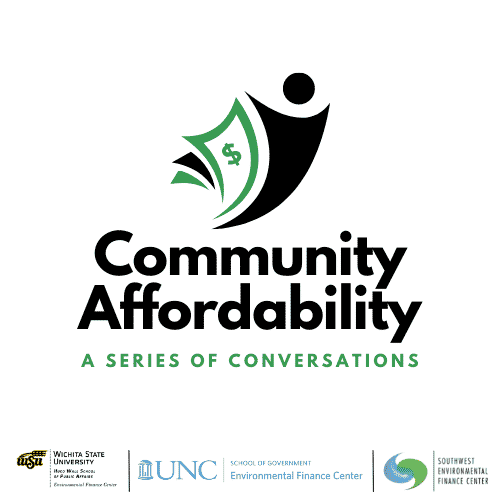 The impact of utility rates on community members is a challenge that water and wastewater utilities across the nation face. It is especially challenging for small systems.
The impact of utility rates on community members is a challenge that water and wastewater utilities across the nation face. It is especially challenging for small systems.
Join the Environmental Finance Centers from Wichita State University, University of New Mexico/Southwest, and University of North Carolina at Chapel Hill for a series that considers community affordability, including empathizing with community members, understanding the impacts of utility rates on customers and utilities, and how to approach potential solutions to balancing the needs of the utility and the community.
What is Customer Impact?
In short, customer impact is the financial burden that utility rates place on your rate-payers. The long answer consists of a variety of calculations that consider household income, other household expenses, and the percentage of household income that goes toward water bills.
Consider your own household expenses. What are your top 4 household expenses?
For the purposes of determining affordability, the top 4 household expenses are rent/mortgage, food, income taxes, and utility expenses. Other expenses should be considered when understanding how families spend their income; however, for the purposes of calculations, these are the main expenses that are considered.
Understanding the expenses households juggle is important. Knowing how rates affect community members can provide insight for how and when to adjust rates, develop assistance programs, and invest in infrastructure. Additionally, having empathy for community members, we can consider options for the low-income, underrepresented, and underserved in our community.
Empathy, by definition, is understanding and being aware of and sensitive to the feelings and experiences of another person. We often try to understand another person’s situation by comparing it to an experience of our own and how we felt in that moment. In reality, we may not be capable of fully understanding an individual’s unique experience because of the complexities and nuances that exist. Trying to make a comparison can instead create false equivalencies that diminish the challenges they are facing and make things seem not so bad. To be truly be empathetic, we need to be able to acknowledge that we can’t always understand what others are going through, but that we still believe their experiences to be valid and true. Instead of trying to create comparison in those moments, we should instead take time to listen and reflect on that person’s experience and learn how to be supportive in that moment.
How are utilities impacted?
Our water and wastewater utilities have minimal standards that they must meet to be in regulatory compliance; however, many utilities strive to provide service that exceeds minimum standards. For example, aesthetic problems with drinking water, such as an off color or taste can be acceptable if all contaminant levels are within regulation, but most of us have clear, tasty water coming out of the faucet.
To maintain minimum standards and determined level of service, utilities require sustainable, reliable funding for day-to-day operations as well as supporting reserve funds and planning for upgrades, major repairs, and replacements.
The Metrics
Generally, a household should not pay more than 2.5% of income on drinking water and no more than 2% of income on wastewater services. These thresholds were developed based on interpretation of EPA’s guidance of affordability per Safe Drinking Water Act rules. Although EPA does not officially establish these thresholds, they are commonly used to understand and assess the affordability of utility rates.
There are several metrics that use different formulas based off census information and utility rates. These are some of the common metrics you may see or hear referenced in affordability research, tools, webinars, etc:
- The Residential Indicator, or sometimes referred to as the “RI” or “traditional” metric is the overall percent of the MHI of the community to pay water/wastewater bills. This metric is taking the average utility bill and dividing it by MHI for your community the to provide an overall snapshot of how utility rates impact your community as a whole.
- The Poverty Prevalence Indicator considers how prevalent poverty is within your community. It can inform you of how widespread poverty in your community is. When compared with other metrics, it can indicate the potential burden that utility rates may have on the members of the community with the lowest-incomes.
- The Household Burden, sometimes just referred to as burden, examines how much of income the households with the lowest income are using to pay water/wastewater bills. In contrast to the Residential Indicator, this metric considers impact on a household level, rather than a community-wide level.
Other metrics that you may see are the Affordability Ratio, which considers the cost of water/wastewater utility bills along with other household expenses. And hours at minimum wage is another way to consider the burden that households with low income may bear.
The Tools
There are tools and resources available for communities to use that can assist with assessing and understanding community affordability issues. These online tools are free to use and can serve as a communication and planning tool for your community!
Southwest Environmental Finance Center – Water Affordability Self-Assessment Tool
University of North Carolina – Chapel Hill Environmental Finance Center Affordability Assessment Tool
For more information about affordability, equity, and additional resources, visit the Wichita State University Environmental Finance Center’s resource page.
